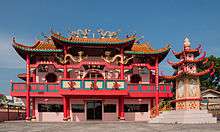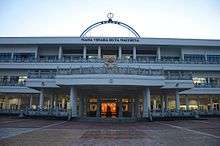Chinese folk religion in Southeast Asia
Chinese folk religion plays a dynamic role in the lives of the overseas Chinese who have settled in the countries of this geographic region, particularly Burmese Chinese, Singaporean Chinese, Malaysian Chinese, Thai Chinese and Hoa. The Indonesian Chinese, by contrast, were forced to adopt en masse either Buddhism or Christianity in the 1950s and 1960s, abandoning traditional worship, due to Indonesia's religious policies which forbade Chinese traditional religion. Chinese folk religion, the ethnic religion of Han Chinese, "Shenism" was especially coined referring to its Southeast Asian expression; another Southeast Asian name for the religion is the Sanskrit expression Satya Dharma (literally "Truth Law").
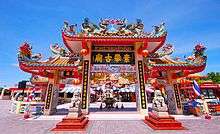
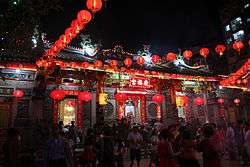
The Chinese folk religion of Southeast Asia is markedly typified by the interaction with Malay indigenous religions (Malaysian and Indonesian folk religion) and the adoption of gods of Hindu derivation, such as Brahma, Ganesha and Hanuman. The philosophical forms of Confucianism and Taoism are followed, and organised forms of the Chinese folk faith, such as the Church of Virtue, Yiguandao and Zhenkongism, have taken significant foothold among Southeast Asian Chinese.
In Singapore about 11% of the total population is Taoist, composed by a 14.4% of the Chinese Singaporeans identifying as Taoists.[1] In Malaysia, around 10% of Chinese Malaysians practice Chinese folk religions, corresponding to around 1% of the whole country population.[2] However, numbers may be significantly larger since many folk religious Chinese register as "Buddhists" for census purposes. In Indonesia, Taosu Agung Kusumo, leader of the Majelis Agama Tao Indonesia, claims there are 5 million Taoist followers in the country as of 2009.[3]
By country
Indonesia
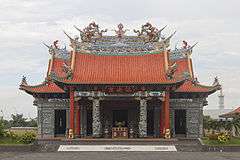
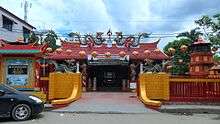
The Chinese folk religion of the Chinese Indonesians is named "Confucianism" or "Satya Dharma", and Chinese temples are called klenteng or vihara in Indonesian language. It is officially recognised by the government as Agama Khonghucu or religion of Confucius, which was chosen because of the political condition in Indonesia before the end of Suharto rule in 1998, who had forbade Chinese religions and the Chinese were forced to convert to Buddhism or Christianity. The Chinese Indonesians had their culture and religious rights restored only after the fourth president of Indonesia, Abdurrahman Wahid, issued a regulation that recognised "Confucianism" among the legal religions of the country. He said that:
All religions insist on peace. From this we might think that the religious struggle for peace is simple... but it is not. The deep problem is that people use religion wrongly in pursuit of victory and triumph. This sad fact then leads to conflict with people who have different beliefs.[4]
The first precept of Pancasila (the Five Basic Principles of the Indonesian state) stipulates belief in the one and only God. The Confucian philosophy is able to fulfill this, for Confucius mentioned only one God in his teaching, the Heaven or Shangdi. The Heaven possess the characteristic of Yuan Heng Li Zhen, or Omnipresent, Omnipotent, Omnibenevolent, Just.[5]
The Master said, "Great indeed was Yao as a sovereign! How majestic was he! It is only Heaven that is grand, and only Yao corresponded to it. How vast was his virtue! The people could find no name for it. How majestic was he in the works which he accomplished! How glorious in the elegant regulations which he instituted!" (VIII, xix, tr. Legge 1893:214)
Another movement in Indonesia is the Tridharma (Sanskrit: "law of the three"), syncretising elements of different religions, the Chinese three teachings amongst others.[6] After the fall of Suharto rule it is undergoing a process of systematisation of doctrines and rituals.[6] Tridharma temples always consist of three main rooms: the front room for Tian or God, the middle for the main deity of the temple, the back room for the three teachers and their pantheon: Confucius, Laozi, and Buddha. Several big Chinese population cities like Medan, Batam, Bagansiapiapi and Singkawang has a significant numbers of Chinese folk religion followers aside Buddhist. There are also many Taoist associations in Indonesia.
Some local deities which are not known outside Indonesia includes Tan Hu Cin Jin from Banyuwangi-Bali, Tan Tik Siu from Tulungagung, Tan Oei Ji Sian Seng or Gi Yong Kong from Rembang-Lasem, and Tey Hai Cin Jin whose worshiped on the coastal cities of East and Middle Java.
Malaysia
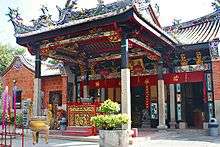
In Malaysia the Malaysian Chinese constitute a large segment of the population, mostly adherent of Mahayana Buddhism. The Chinese traditional religion has a relatively significant registered following in the states of Sarawak (6%) and Penang (5%). Many other folk religious Chinese register as "Buddhists" in government surveys. Chinese temples are called tokong in Malaysian language.
The Chinese folk religion was brought for the first time into Malaysia by Chinese emigrants in the 15th century, with small settlements that were established in Melaka by Hokkien traders, but it was not until the 19th century that there was a mass migration of Chinese. They built shrines dedicated to their deities and cemeteries for those who died. The Chinese migration during the tin and gold mining days, which were a result of high demand for these products, prompted the need of temples, for practices and religious rituals.[7]
Social organisations in the Chinese immigrant society were important, where surnames, dialect, locality and trade mattered. The Cantonese, Hokkien, Teochew and Hakka, respectively formed their secret societies, such as the Ghee Hin and Hai San, and they played grassroots government of the Chinese communities.[7]
A prominent cult is that of Tua Pek Kong (大伯公 Dabo Gong), and it has incorporated the cult of the Na Tuk Kong (拿督公 Nadu Gong) of local Malay origin. Other Malay and Thai gods have been incorporated into the pantheon.
Thailand
Thailand has a large population of Thai Chinese, people of Chinese or partial Chinese origin (up to 40% of the population of the country). Most of those who follow Buddhism have been integrated into the Theravada Buddhist tradition of the country, with only a negligible minority still practicing Chinese Buddhism. However, many others have retained the Chinese folk religions and Taoism.[8] Despite the large number of followers and temples, and although they are practiced freely, these religions have no state recognition, their temples are not counted as places of worship, and their followers are counted as "Theravada Buddhists" in officially released religious figures.[8] In Thailand, Chinese temples are called sanchao (Thai: ศาลเจ้า).[8]
Like in other Southeast Asian countries, the Chinese folk religion of Thailand has developed local features, including the worship of local gods.[8] Major Chinese festivals such as the Nian, Zhongqiu and Qingming are widely celebrated especially in Bangkok, Phuket, and other parts of Thailand where there are large Chinese populations.[9]
The Chinese in the city of Phuket are noted for their nine-day vegetarian festival between September and October. During the festive season, devotees will abstain from meat and mortification of the flesh by Chinese mediums are also commonly seen, along with rites devoted to the worship of Tua Pek Kong. Such traditions were developed during the 19th century in Phuket by the local Chinese with influences from Thai culture.[10]
Singapore
.jpg)
Sizeable number of Chinese Singaporeans practice Taoism, which in the city state is used as a synecdoche for broader Chinese folk religion. Taoists in Singapore worship many Deities, that frequently are embodied by historical ancestors and are subject to a complex Taoist hierarchy of veneration. They also worship some deities of common origins, notably the Jade Emperor, Xuan Tian Shang Di, Lord Guan, and Tian Shang Sheng Mu. Other deities that were venerated and frequently keep at home as auspicious images include the Fu, Lu, and Shou. Caishen is also popularly venerated by many Chinese businessmen. However, certain deities are worshipped by a particular dialect group, and may not share a common devotion with other Chinese dialect groups. One interesting example will be Qing Shui Zhu Shi(祖師公), this particular Deity is mainly worshipped by the Hokkien, particularly from Anxi Clan. Deities from other ethnicity, like Na Tuk Kong (拿督公) or Datuk Keramat are also venerated.
Adherents of Taoism or Chinese Folk Religionists would placed their main altars/shrines inside their living room. This is more often seen among Chinese families, rather than individuals. The main Gods/Deities would be enshrined at the centre of the top altar, and a tablet dedicated to the Guardians of Earth/Dizhushen (地主神) would be placed at the bottom altar. Ancestral tablets are usually placed beside the statues/images of the main Gods/Deities at the top altar. Often, urn, usually placed with some incense sticks, is placed in front of the Gods/Deities and a separate smaller urn will be placed in front of the ancestral tablet. Oil lamps may also be placed at altars, and fruit or flower offerings are also placed in front of the Gods/Deities as offerings. Some families may also have an altar dedicated to the Kitchen God (灶君) inside the kitchen.
They will usually installed a small altar/shrine, painted red and gold, with the words "Heaven Official Bestows Blessings" (天官赐福) written on it outside the house or simply a small urn filled with ash where incense sticks are placed. This is dedicated to Tian Kong (天公)/Jade Emperor (玉皇大帝) and is the first altar that they will worship. After they have worship toward the Heaven representing Tian Kong/Jade Emperor, they will proceed to worship at the main altar to the Gods/Deities, then to the ancestral tablets and eventually to the Guardians of Earth/Dizhushen. The smoke emitted from burning incense sticks symbolize their devotion and prayer, and at times requests, to the Gods/Deities.
Vietnam
Many Hoa people (Han Chinese of Vietnam) practice Chinese folk religion.
Features
Organised traditions
Some organised sects stemming from Chinese practises have been active among Southeast Asian Chinese. They include especially De jiao ("religion of virtue"),[11][12][13] Zhenkong jiao ("Teachings of True Emptiness")[14] and Yiguandao ("Consistent Way").[14]
Southeast Asian Chinese pantheon
The names of the gods are in transcribed Mandarin or certain Chinese dialects spoken by Southeast Asian Chinese populations:
- Teen Kong (天公) "Lord of Heaven" also known as the Jade Emperor
- Xuan Tian Shang Di (玄天上帝) or Siong Teh Gong (上帝公), Powerful Deity and was known as the Patron Deity of Ming Dynasty
- Hou Tu (后土) or Di Mu Niang Niang (地母娘娘), known as Goddess Queen of the Earth
- Xi Wang Mu (西王母) , an ancient Deity and was highly honored
- Dou Mu Yuan Jun (斗母元君), Mother Goddess of the Big Dipper or Lady Mother of the Chariot
- Kew Ong Yah (九皇爷), Nine Emperor Gods who symbolized the nine stars of the Big Dipper, was known in Malay as "Perayaan Dewa Sembilan Maharaja"
- Guan Teh Gong (關帝公) or Guan Sheng Di Jun (關聖帝君) or "Lord Guan" - God of Military, Symbol of Righteousness and Justice, Patron Deity of police, businessmen and secret societies
- Kuan Yim Hood Chor (觀音佛祖) or also known as Avalokiteśvara - Goddess of Mercy or Bodhisattva of Compassion
- Jiu Tian Xuan Nü (九天玄女) Lady of the Nine Heavens, an ancient Deity and also worshipped as Goddess of War
- Ma Zu (媽祖) or Tian Shang Sheng Mu (天上圣母), Goddess of the sea, Patron Deity of fishermen, sailors and any occupations related to sea/ocean, also regarded as Patron Deity for Lim (林) Clan
- Ong Yah Gong (王爺信仰), Divine Emissaries (代天巡狩) who tour the world of the living on behalf of the Jade Emperor, expelling disease and evil
- Qing Shui Zhu Shi (清水祖師) or Cho Su Gong (祖師公), Patron Deity of Anxi County in Quanzhou
- Bao Sheng Da Di (保生大帝), Patron Deity of Tong'an District in Xiamen, also worshipped as a Medicinal Deity
- Guang Ze Zun Wang (廣澤尊王), Honorific King of Great Compassion, Patron Deity of Nan'an City in Quanzhou
- Kai Zhang Sheng Wang (開漳聖王), Patron Deity of Zhangzhou
- Tua Pek Kong (大伯公) or Fu De Zheng Shen (福德正神)
- Hua Tuo (華佗), was regarded as "divine physician" in Chinese history and worshipped as a Medicinal Deity
- Qi Tian Da Sheng (齊天大聖) or Dai Seng Yah (大聖爺),the popular and powerful Monkey God
- Seng Ong Yah (城隍爺), Patron Deity of City or City God
- Choy Sun Yeh (财神 "Wealth God")
- Wen Chang Di Jun (文昌帝君), God of Culture and Literature, Patron Deity of scholars and students
- Zhu Sheng Niang Niang (註生娘娘), Goddess of fertility and children
- Yue Xia Lao Ren (月下老人), Patron Deity of marriage and love
- He-He Er Xian (和合二仙), Immortals of Harmony and Union, associated with happy marriages
- Hua Gong Hua Po (花公花婆) Patron Deities and Protector of children
- Tai Yang Xing Jun (太陽星君) Sun God
- Tai Yin Niang Niang (太陰娘娘) or Chang Er (嫦娥), Moon Goddess, worshipped by female devotees during Mid-Autumn Festival
- Tai Sui (太歲) 60 Heavenly Officials who will be in charge of each year during the Chinese sixty years cycle
- Wu Ying Jiang Jun (五營將軍 The Celestial Generals of Five Directions)
- Teh Choo Kong (地主公) "Earth Lord" or Di Zhu Shen (地主神) "God of the Purified Place"
- Ho Yah Gong (虎爺公) "Tiger Deity" who guard the temples and was worshipped for protection against bad luck, dangers and enemies
- Zao Jun (灶君), Kitchen God and also known as the Stove God
- Men Shen (門神), Divine Guardians of doors and gates
- Tua Li Yah Pek (大二爺伯), Underworld Deities who are in charge of escorting or arresting the spirits of the dead, also been highly regarded for their brotherhood spirit
- Gu Tao Baey Bin (牛頭馬面), Guardians of the Underworld
- Jin Qian Bo (金錢伯), Popularly known in English as Uncle Moneybags, who oversees incense money transmission from the living realm to the realm of the dead (Underworld)
- She Mian Shen (四面神), also known as Four Faced Deity, who is also known as Brahma
- Na Tuk Kong (拿督公), also as Dato Gong or Datuk Gong, related to Datuk Keramat in Malaysian folk religion
Places of worship and practice
Chinese temples in Indonesia and Malaysia are called kelenteng, klenteng, tokong or pekong in local Malay languages, or alternatively bio, the southern Chinese pronunciation of Mandarin miao (庙). In Thailand their name is sanchao (Thai: ศาลเจ้า). Items for Chinese religious practices in Southeast Asia are supplied at shén liào shāngdiàn (神料商店 "shops of goods for the gods").
See also
| Wikimedia Commons has media related to Chinese temples in Indonesia. |
| Wikimedia Commons has media related to Chinese temples in Malaysia. |
| Wikimedia Commons has media related to Chinese temples in Singapore. |
| Wikimedia Commons has media related to Chinese temples in Thailand. |
| Wikimedia Commons has media related to Chinese temples in Vietnam. |
References
- Singapore Department of Statistics (12 January 2011). "Census of population 2010: Statistical Release 1 on Demographic Characteristics, Education, Language and Religion" (PDF). Archived from the original (PDF) on 3 March 2011. Retrieved 16 January 2011.
- "2010 Population and Housing Census of Malaysia" (PDF). Department of Statistics, Malaysia. Archived from the original (PDF) on 13 November 2013. Retrieved 17 June 2012. p. 13
- "Tao, Taoism Religion". Indonesiamatters.com. Retrieved 20 November 2011.
- Ambassadors for the Universal Peace Federation. Reverendsunmyungmoon.org.
- Bidang Litbang PTITD/Matrisia Jawa Tengah. 2007. Pengetahuan Umum Tentang Tri Dharma, First Edition (July 2007). Publisher: Benih Bersemi, Semarang, Indonesia.
- Tsuda Koji. "Chinese Religion" in Modern Indonesia: Focusing on the Trend Toward Systematization in the Post-Soeharto Era. Tokyo University of Foreign Studies.
- Encyclopedia of Malaysia, vol. Religions & Beliefs, edited by Kamal Hassan, Ghazali bin Basri. ISBN 981-3018-51-8
- Tatsuki Kataoka. Religion as Non-religion: The Place of Chinese Temples in Phuket, Southern Thailand. In Southeast Asian Studies, Vol. 1, No. 3, December 2012, pp. 461–485. Center for Southeast Asian Studies, Kyoto University.
- Tong Chee Kiong; Chan Kwok Bun (2001). Rethinking Assimilation and Ethnicity: The Chinese of Thailand. Alternate Identities: The Chinese of Contemporary Thailand. pp. 30–34.
- Jean Elizabeth DeBernardi (2006). The Way That Lives in the Heart: Chinese Popular Religion and Spirits Mediums in Penang, Malaysia. Stanford University Press. pp. 25–30. ISBN 0-8047-5292-3.
- Bernard Formoso. De Jiao - A Religious Movement in Contemporary China and Overseas: Purple Qi from the East. National University of Singapore, 2010. ISBN 978-9971-69-492-0
- Kazuo Yoshihara. Dejiao: A Chinese Religion in Southeast Asia. In Japanese Journal of Religious Studies, Vol. 15, No. 2/3, Folk Religion and Religious Organizations in Asia (Jun. - Sep., 1988), pp. 199–221. Published by: Nanzan University
- Chee Beng Tan. The Development and Distribution of Dejiao Associations in Malaysia and Singapore, A Study on a Religious Organization. Institute of Southeast Asian Studies, Occasional Paper n. 79. Singapore: Institute of Southeast Asian Studies, 1985. ISBN 978-9971988142 (Note: Book review has a typo in the ISBN)
- Vincent Goossaert, David Palmer. The Religious Question in Modern China. University of Chicago Press, 2011. ISBN 0226304167 p. 108
